Algae is an extremely diverse group of organisms that make up the lower phylogenetic echelons of the plant kingdom. A precise definition of this group is elusive and they share many obvious characteristics with higher land plants, whereas their distinguishing features from other plant groups are varied and more subtle according to the classification of Bold and Wynne 1985. Bold and Wynne (1978) recognized nine divisions of algae retaining the nomenclature given by Papenfuss (1946), except for blue-green algae.
(To know about the last three divisions of Bold and Wynne (Euglenophyta, Phaeophyta, Chrysophyta), follow this link below:
Bold & Wynne’s Divisions: Euglenophyta, Phaeophyta, Chrysophyta
In this article, the last three divisions of this classification (Pyrrhophyta, Cryptophyta, Rhodophyta) will be characterised briefly:
Pyrrhophyta
Best safe and secure cloud storage with password protection
Get Envato Elements, Prime Video, Hotstar and Netflix For Free
Best Money Earning Website 100$ Day
#1 Top ranking article submission website
Example: Gynidium mirabile, Noctulica, Protoperidium etc.
Common name: The common name of this division is Dinoflagellates.
Habit: Usually they are microscopic, unicellular dinoflagellate organisms that may form colonies or filaments.
Habitat: They are extremely abundant in marine and freshwater habitats but also occur in brackish water. Generally they don’t occur below 50m and use flagella to stay up to water column.
Cell wall: Cell wall is thick in which cellulose may be present or absent and mucillaginous substances may be present.
Color: They are usually yellow-green and some brown in color for the presence of accessory pigments.
Pigments: Pigments found in this division are Chlorophyll a, c, β-carotene and several xanthophylls as accessory pigments are also present.
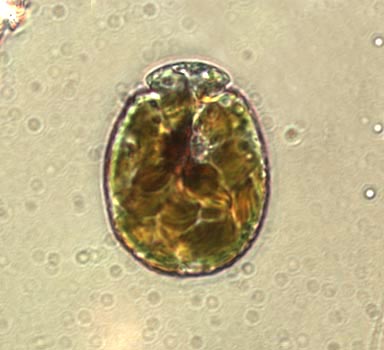
Plastid organization: Three thylakoids or stacks are present in the plastid organization of the photosynthetic plants.
Storage product: The storage product of this division is Starch, α-1,4-glucan (oil in some species). Starch remains stored outside the chloroplast.
Flagella: Two unequal flagella are present; one is trailing and the other is girdling (apically inserted).
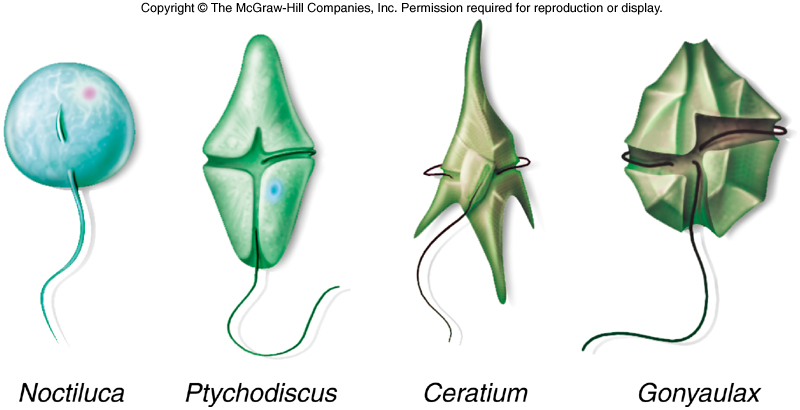
Members of Pyrrhophyta. Source: slidetodoc
Reproduction: Reproduction occurs asexually by mitosis.
Toxin: Overpopulation of this algae is responsible for red tides (algal bloom of dinoflagellates that secrete toxins that can cause illness, paralysis, fish kills, and human death).
They can be luminescent by producing lights and are known as fire algae.
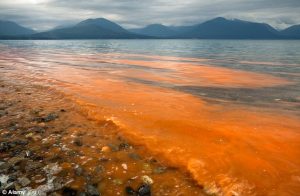
Cryptophyta
Common name: This division is named Cryptomonads (a group of biflagellate organisms).
Habit: In this division, cells are slipper and flattened shaped which usually occur singly. They have a slit-like furrow at the anterior.
Habitat: They are mainly common in freshwater but also occur in marine and brackish water.
Cell wall: Cell wall is totally absent but very few have cellulose-made walls and are surrounded by plasmalemma with a thin granular material on the outside.
Pigments: Pigments found in this division are chlorophyll a and c. Besides, α- nd β- carotene, distinctive xanthophylls (alloxanthin, crocoxanthin and monadoxanthin), and the phycobilin pigments are also present in this group.
Cells of Cryptomonads also contain the accessory pigments such as phycocyanin (blue) or phycoerythrin (red) which are responsible for the cell’s color and may appear red, yellowish green, or brown in color.
Plastid organization: There are one or two plastids with or without pyrenoids and two stacked thylakoids are present in it.
Storage product: The storage product of this division is Starch, α-1,4-glucan.
Flagella: Two flagella are present in them which are unequal in size and insertion is sub-apical type.
Cell invagination with ejectosomes present in them which can help in propulsion.
Cryptomonas platyuris. Source: PtotistReproduction: Reproduction is occurred by longitudinal cell division or by zoospores by cysts.
Toxin: They don’t produce any type of toxins and are used to feed small zooplankton as the food source for small fish in fish farming.
ffffffffff
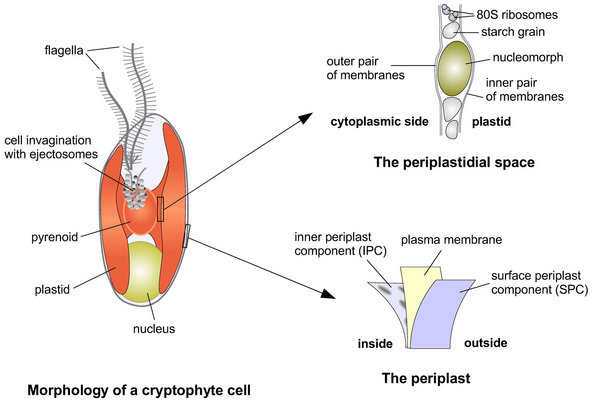
Source: TolwebNucleomorph (vestigial nucleus of the primitive symbiotic organism) can be found in them.
Cryptomonas is an example of unicellular algae of this division. Recently there are 26 species of Cryptomonas.
Rhodophyta ( the Red Algae)
Common name: Red algae.
Habitat: This division includes about 4000 species of primarily marine plants. Only about 2% of this total inhabits freshwater.
Cell wall: The cell wall is mainly made up of cellulose but some Bangiales have mannans and xylans as the primary wall component. Xylans, several sulfated polysaccharides (Galatians) calcification occurs in some species. Alginate is found in Corallinaceae.
Some coralline red algae deposit calcium carbonate in their cell walls. This deposition prevents them from being eaten and gives them strength and support. These algae contribute to the growth of coral reefs.
Color: Reddish.
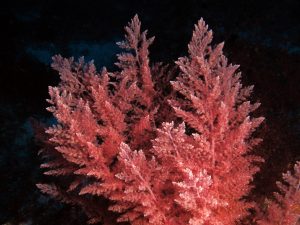
Member of Rhodophyta. Source: Pinterest
Pigments: Pigments found in this division are chlorophyll ‘a’ (possibly chlorophyll ‘d’ in some Floredeophyceae). α- and β- carotene, several xanthophylls, and the phycobilin pigments allophycocyanin, R-and C-phycocyanin, and R-and B-phycoerythrin as accessory pigments are also present in this group.
Phycoerythrin is responsible for the red color for which the group is named as red algae, but sometimes photo-destruction of this pigment or chromatic adaptation will give the plant a greenish or yellowish aspect.
As an accessory pigment R-and B-phycoerythrin can absorb shorter wavelengths of light and allows them to live more deeply (to 200 m) than other plants.
Plastid organization: Plastid is organized by single thylakoids which are not associated with each other(unstacked).
No chloroplast endoplasmic reticulum is present in this group.
Storage product: The storage product of this division is Floridian starch (amylopectin-like).
Flagella: Flagella is totally absent in this division.
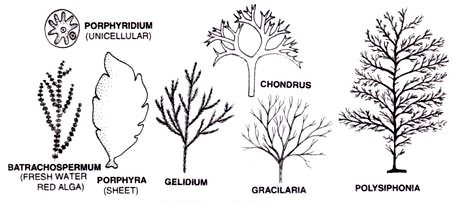
Some examples of red algae (Rhodophycophyta). Source: Biologydiscussion Secondary products such as carrageenan are made from Gigartina stellata, Chondrus crispus, and Eucheuma and Agar is made from Gelidium, Gracilaria, Pterocladia and Ahnfeltia.
Some marine species of red algae have a parasitic lifestyle and may be found on closely or more distantly related red algal hosts.
References & Other Links
- Introduction to the Algae written by H. C. Bold & M. J. Wynne 1978.
- https://link.springer.com
- https://www.slideshare.net
Revised by
- Somudro Mahbub Nasir on 11 July 2021
Written by
Tubaia Zannat Juthi, B.S. (Hons), Department of Botany, University of Dhaka
 Plantlet The Blogging Platform of Department of Botany, University of Dhaka
Plantlet The Blogging Platform of Department of Botany, University of Dhaka
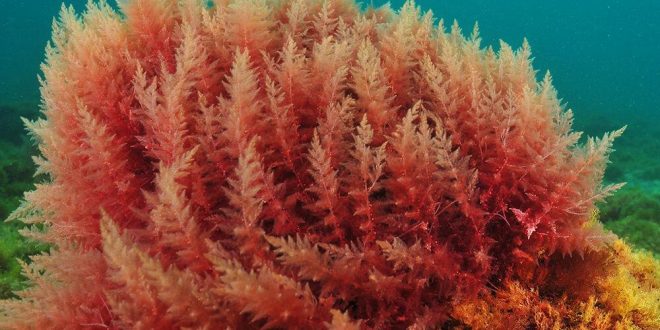
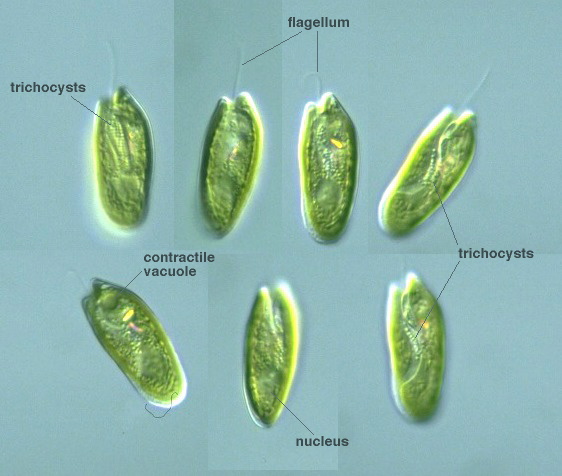

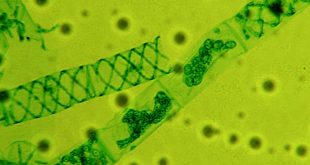
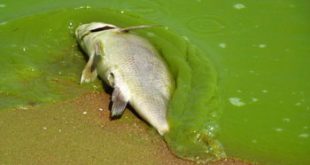
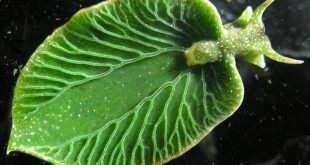
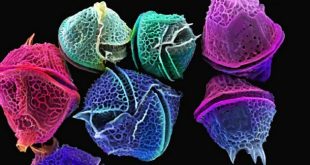
I have read your article carefully and I agree with you very much. This has provided a great help for my thesis writing, and I will seriously improve it. However, I don’t know much about a certain place. Can you help me?